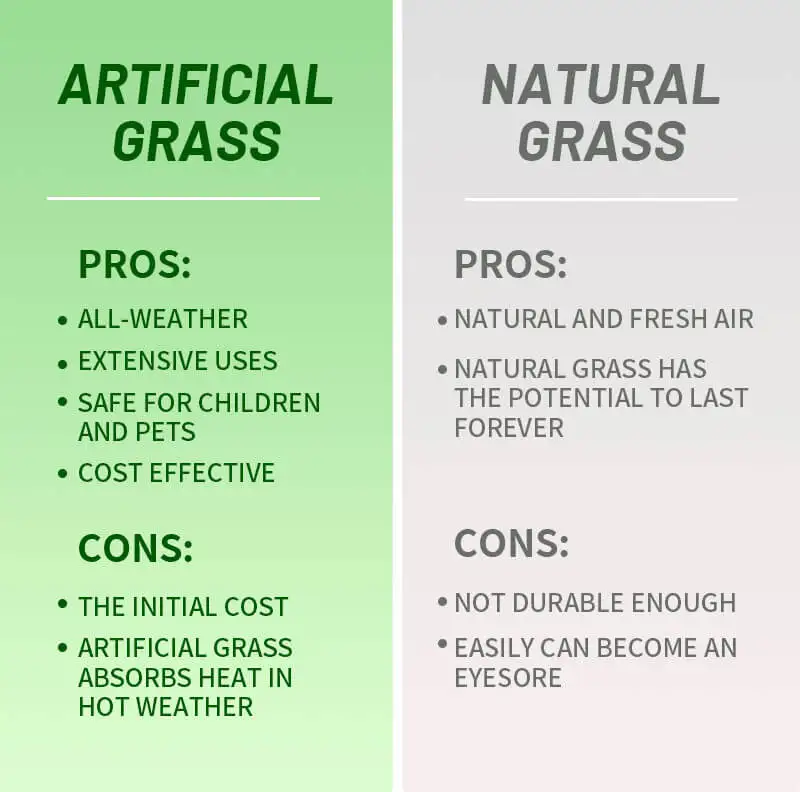Artificial grass is a great option for those who want a low-maintenance lawn. It doesn't require as much time and effort as traditional grass, making it a popular choice for busy people. However, there are some trade-offs to consider before deciding if artificial grass is right for you. Natural grass also has its own advantages, so it's important to weigh all your options before making a decision.
Pros of Artificial Grass
Artificial lawns are a great option for anyone looking for a green space that is low-maintenance and easy to care for. Synthetic turf is also perfect for areas that might be difficult to maintain natural grass, such as decks, poolsides, roof terraces, play areas, offices, exhibition spaces, balconies, restaurants, and hotels. Artificial grass is also safe for children and pets, as it is soft and cushioned and requires no chemicals or pesticides.
The cost-effectiveness of synthetic turf pitches is well-documented, especially when the income from external bookings is taken into account. In addition, most surfaces can host more than one sport; for example, football and rugby go very well together.
CCGrass’s multi-purpose systems have been used by a large number of universities, communities, and amateur clubs because they maximize function and minimize cost.
Cons of Artificial Grass
The initial cost of installing an artificial lawn can be significant, but the results are worth it. Most homeowners pay for counseling, artificial grass, and installation. The cost of a project depends on the area of artificial turf you need to install. We offer free consultations and evaluations for anyone considering turf.
Artificial grass absorbs heat in hot weather, but it doesn't cause any burns. There are many easy ways to keep your synthetic turf from getting too hot even on a hot summer day.
Pros and cros of Natural Grass
There are both pros and cons to having natural grass. Some pros include that it releases oxygen, captures carbon dioxide, and can help purify the air. However, some cons to natural grass include that it does not last as long as other materials, can be an eyesore if not maintained well, and is affected by the environment and weather.

Differences between Natural Grass and Artificial Grass
There are several key differences between natural grass and artificial turf, including aesthetics, maintenance, cost, and environmental impact.
Aesthetic-wise, natural grass certainly has a more traditional and natural look. However, without putting in a lot of time and effort (or money for a gardener), it can be difficult to keep real grass looking flat, green, and weed-free. In arid regions especially, natural grass needs irrigation at least twice a day in order to survive.
On the other hand, artificial grass comes in a variety of colors, piles, lengths, densities, textures, yarns, and design options – meaning you can customize it to your needs and style choices. At CCGrass, we design our artificial grasses to look as natural as possible while still having different personalities. This way, you can get the best of both worlds: a lawn that looks aesthetically pleasing without all the work that goes into maintaining real grass.
Which Should You Choose for Your Lawn?Real Grass vs. Fake Grass
Choosing between real and fake grass for your lawn can be a tough decision. If you're the type of person who loves to care for and maintain their garden, then real grass may be the better option for you. However, if you're open to the idea of a free weekend and Lean toward a "set it and forget it" landscaping option, then artificial turf might be what you're looking for.Some things you might want to consider before making your decision are:
- Where you live (real grass may not do well in dry climates)
- How much time you're willing to spend caring for your lawn
- If you're interested in saving water
If you decide that artificial grass is right for you, CCGrass can provide you with high quality fake turf at an affordable price. Contact us on 86 25 6981 1666 or email info@ccgrass.com for free samples and quotes!

